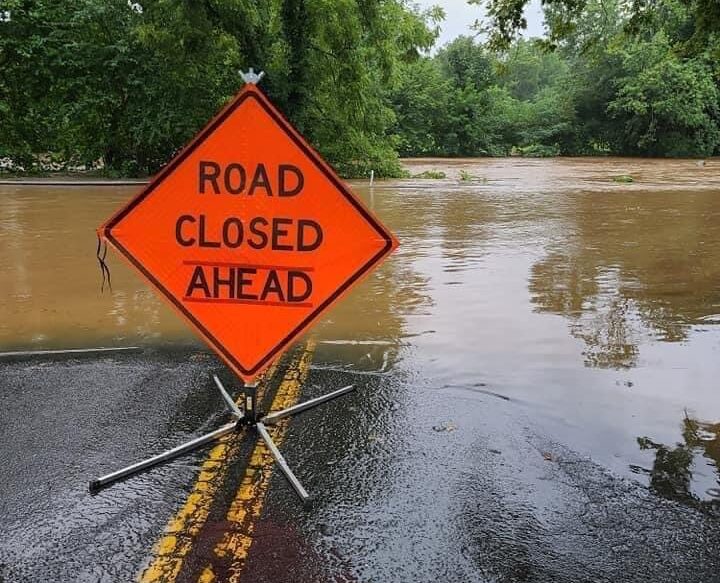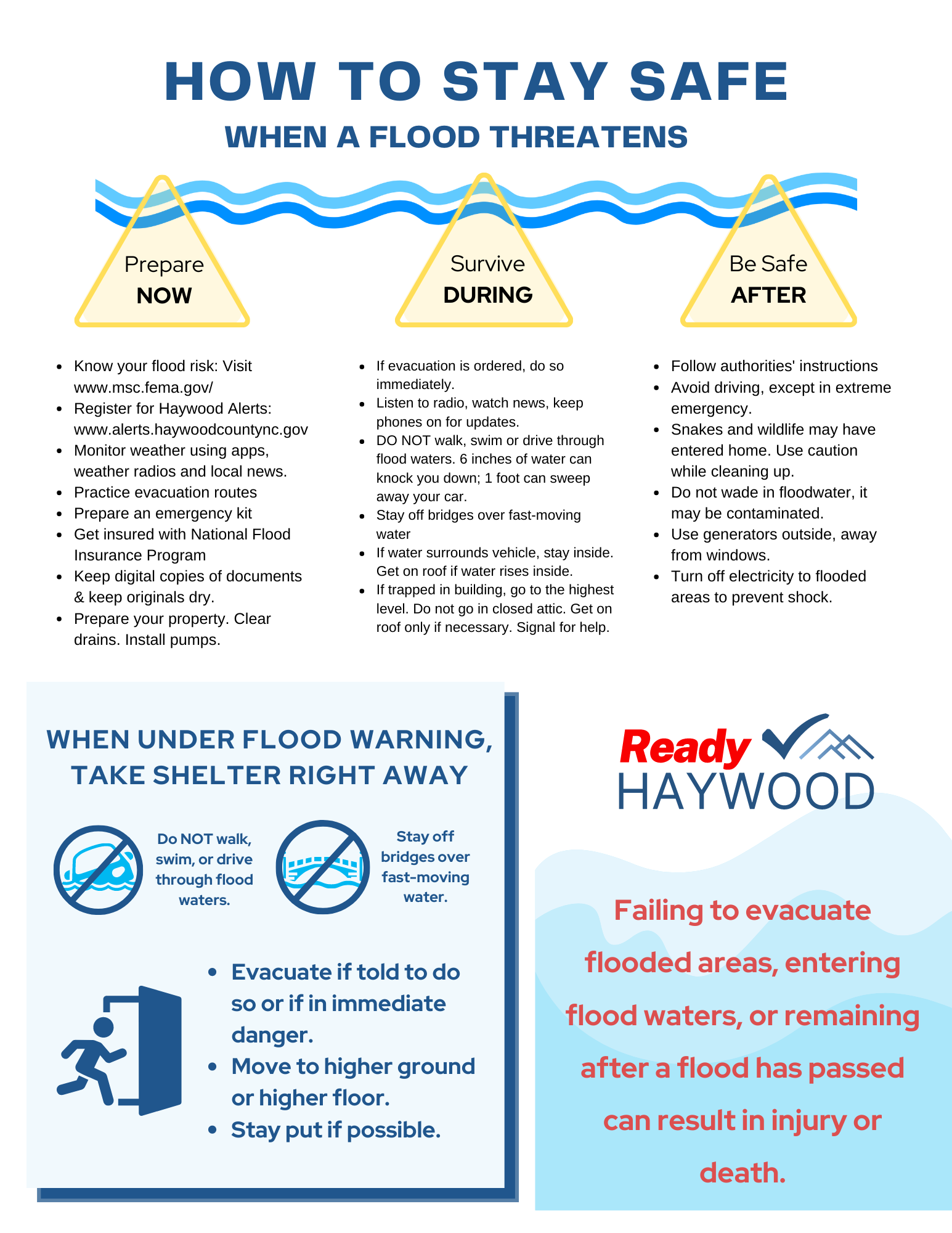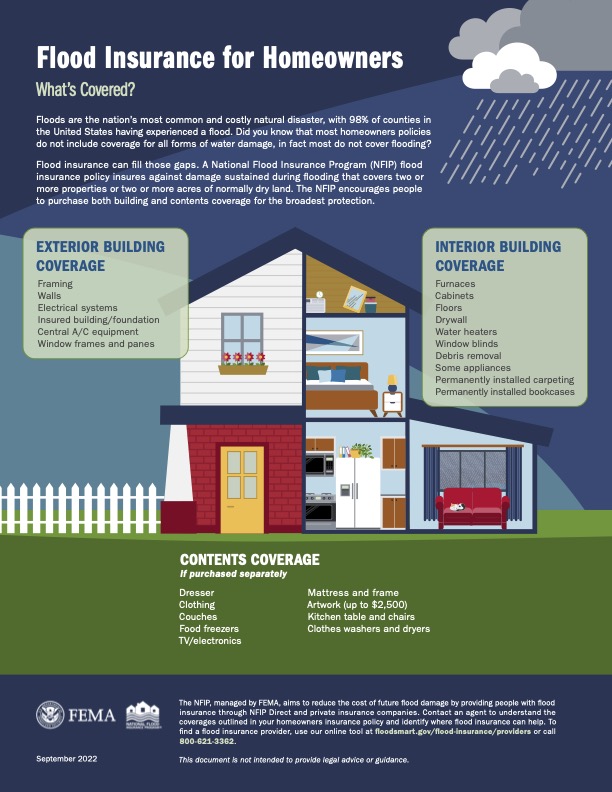Here in the mountains, flooding can happen as a result of many factors including hurricanes and tropical storms, heavy rains, flash floods, and new development.
Haywood County Emergency Services and Haywood County Government have adopted, and encourage, policies and standards that protect life and property, prevent flooding, preserve stream channels, and minimize water pollution.
Haywood County is StormReady. Is your family?

River Gauges
Real-Time Water Levels
The North Carolina Flood Inundation Mapping and Alert Network provides near real-time river gauge and weather RADAR data.
Flood Ordinances
Flood Damage Prevention Ordinances
Chapter 155 of the Haywood County Ordinances deals with flood damage prevention, flood hazard reduction, flood zone construction standards, and more.
Flood Maps
Know Your Flood Risk
The first step in flood safety is knowing your risk. Knowing where your property is in relation to flood zones will help you be better prepared in the event of a flood event.
Resources
NC Flood Risk Information System — Searchable by address
National Flood Insurance Program — Learn about and apply for NFIP @www.floodsmart.gov
Understanding Flood Insurance — What is covered; how does it work?
FEMA Flood Map — Searchable by address
Permitting — Who permits what in Haywood County?
How is a flood defined?
Flood or Flooding means a general and temporary condition of partial or complete inundation of normally dry lands areas from:
- The overflow of waters from channels, drainageway or reservoir spillways; and/or
- The unusual and rapid accumulation or runoff of surface waters from any source.
What is a floodplain?
A Floodplain or a Flood-Prone Area means any land area susceptible to being inundated by water from any source during a 100-year flood as defined by FEMA, FHADs, or channels or drainageways with tributary areas that are 130 acres or greater.
Types of Floods
There are several different types of floods. Most communities experience only a few of them. Floods are generally grouped into the following types —
- Riverine flooding
- Urban drainage
- Ground failures
- Fluctuating lake levels
- Coastal flooding and erosion
NC Floodplain Management: Quick Guide
The North Carolina Division of Emergency Management Floodplain Management Branch prepared this Quick Guide to help you understand more about why and how communities in the state of North Carolina manage floodplains to protect people and property.
NC Floodplain Management: Quick Guide
The North Carolina Division of Emergency Management Floodplain Management Branch
prepared this Quick Guide to help you understand more about why and how communities
in the state of North Carolina manage floodplains to protect people and property.
NC Floodplain Management: Quick Guide
The North Carolina Division of Emergency
Management Floodplain Management Branch
prepared this Quick Guide to help you
understand more about why and how
communities in the state of North Carolina
manage floodplains to protect people and
property.
National Flood Insurance Program
Floods can happen anywhere, and most property insurance policies don’t cover food damage. As such, it’s important for Americans to protect their most important financial assets— their homes, businesses, and possessions.
The National Flood Insurance Program (NFIP) was established by Congress on August 1, 1968, with the passage of the National Flood Insurance Act (NFIA) of 1968. Managed by the Federal Emergency Management Agency (FEMA), this program enables property owners and renters in participating communities to purchase insurance against food losses in exchange for communities adopting and enforcing regulations that reduce food damage.
The NFIP has received 2.5 million claims throughout its history and today protects over $1.3 trillion in assets for more than 5 million policyholders.
NFIP flood insurance policies are separate policies to property insurance that can cover buildings, the contents in a building, or both. They’re available in more than 22,500 communities across the country, ranging from low- to moderate-risk areas to high-risk areas.
To purchase flood insurance, property owners, renters, and business owners can call their insurance company or insurance agent. The same person who sells their home or auto insurance can likely sell them a flood insurance policy—if they participate in the Write-Your-Own (WYO) program.
Consumers can also buy a policy through NFIP Direct.
Find coverage:
Visit FloodSmart.gov/find or call the FEMA Mapping and Insurance eXchange (FMIX) center at (877) 336-2627.
For additional information, questions, or requests please contact us at NFIPHelp@ncdps.gov. Please be sure to include your contact information (name, e-mail or phone number) within the body of your request.
Before it Floods
- Sign up for Haywood Alerts
- Find out if your property is in a designated flood zone.
- Purchase flood insurance. Flood losses are rarely covered under renters’ or homeowners’ insurance policies. Typically there is a 30-day waiting period for flood insurance to become active under a new policy. Take the time to understand your flood insurance policy.
- Avoid building in a floodplain unless you elevate and reinforce your home.
- Be Prepared. Develop an emergency plan and create an emergency kit. Inform yourself about floods.
- Keep a supply of fresh water on hand.
- Clean out storm drains near your home or business, removing any debris.
- Create an inventory of your personal property and its approximate value. Save receipts from expensive items.
- Have a battery-operated flashlight.
- Have a battery-operated radio, TV, or internet access that does not rely on electricity.
- Sign up for Haywood Alerts
During a Flood
- Call 911 to report potentially dangerous flooding
- Visit ReadyHaywood.com for updates
- Do not let children play near creeks or streams when the water is rising.
- Be aware that flash flooding can occur. If there is any possibility of a flash flood, move immediately to higher ground (do not wait for instructions to move).
- Secure your home. If you have time, bring in outdoor furniture. Move essential items to an upper floor.
- Do not walk, or swim, through flowing water. The current in just six inches of water can sweep you off of your feet. Flood waters may be contaminated.
- Do not drive through standing water. 1 foot of water can sweep cars away. If your vehicle stalls, abandon it and get to higher ground. Do not try to push it out of the water.
- If told to evacuate your home, do so immediately. Know your evacuation routes and shelters.
- Turn off utilities at the main switches or valves if instructed to do so, disconnect electrical appliances, and do not touch electrical equipment if you are wet or standing in water.
After the Flood
- Download: Coming Home After a Flood
- Follow authorities’ instructions.
- Tune to local TV, radio, and social media for updates.
- Avoid moving water and driving, except in an emergency.
- Report any downed power lines to your utility company.
- Use generators outside, away from windows (not in basements, or garages).
- Use extreme caution when entering buildings; there may be hidden damage, particularly in foundations.
- Do not use appliances or motors that have gotten wet. Take them to a professional to be cleaned and dried.
- Clean and disinfect everything that got wet. Mud left from flood waters can contain sewage and chemicals.
- Throw away any food and medicine that may have been in contact with floodwater.
- Report potential hazards and storm damage.
- All structures affected by flooding will need to obtain building and flood permits from the Development Services Department.
- You may proceed with cleanup activities and temporary emergency repairs to prevent further deterioration, such as preventing the spread of mold and/or mildew without a permit.



